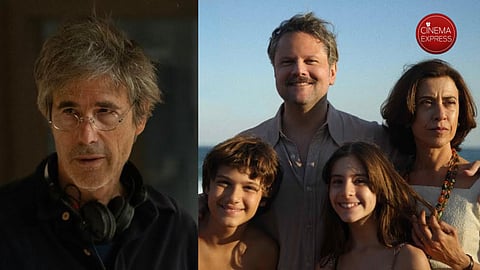Walter Salles: What is happening in Brazil is the return to the collectiveness of cinema
Well-known Brazilian filmmaker Walter Salles’ new film I’m Still Here, based on Marcelo Rubens Paiva’s 2015 book Ainda Estou Aqui, is a real-life account of the horrors faced by his family at the hands of the Brazilian military dictatorship in the early 70s. It is centred on Marcelo’s mother Eunice Paiva who finds life for herself, and her five children, turning upside down when her husband and former Brazilian Labour Party congressman Rubens Paiva (Selton Mello) goes missing.
A film in which the personal becomes the political, I’m Still Here is a cautionary tale on state persecution and violence, which more often than not offers no legal recourse to the affected.
The Brazilian entry for Best International Feature Film at the 97th Academy Awards, the film had its world premiere in Venice where it won the Best Screenplay award. Salles, best known for celebrated works like the Berlinale winner Central Station and the hugely popular The Motorcycle Diaries, about a young Che Guevara played by Gael Garcia Bernal, has again hit the bulls’ eye with I’m Still Here, which has turned out to be the biggest Brazilian hit since COVID-19, that too despite calls for a boycott by the country’s far-right.
It was recently shown as part of the Gala Screenings at the 21st Marrakech International Film Festival where Salles interacted with the international press.
He spoke about adapting Marcelo Rubens Paiva’s book into the film, how it is breaking all the records at the Brazilian box office, his equation with Fernanda Torres who plays the main role in it, the return to the collective experience of watching a film and how the injustices of the military dictatorship of the 70s that the film deals with have not been addressed in the country till date. Excerpts from the conversation:
Why didn't anything happen for the people who were killed [by the military dictatorship] at that time?
It’s because as opposed to what happened in Argentina and in Chile, the crimes committed by the dictatorship in Brazil in the 70s were not punished. Nobody was imprisoned. A film that I love—Santiago Mitre’s Argentina, 1985 is a story [about the trial of the members of the country’s military government] that could not be told in Brazil.
This is what is ultimately leading so many filmmakers to look at that period again, and bring up this question that you just did—why? It’s a question that's been asked many times because we almost drifted again to an oppressive regime. There are many documentaries that have surfaced about the period, and some are truly excellent.
You have had a close relationship with the Paiva family. Did that get you interested? Is it like a personal film?
It is by far the most personal film I've developed. At the same time, it's inspired by the book. It's the blend of all the layers that he portrayed in his book and the glimpses of memory that I had of my own adolescence.
Fernanda Torres’ [who plays the mother] face is where your film truly resides. The impending doom seems to lurk in her expressions…
She perceives things and anticipates them in the scene where they are doing that group photo on the beach. She has the sensitivity for that. She had the capacity to actually be there, but at the same time also understand what was going on outside the walls of the house.
Marcello’s book is ignited by the fact that she was starting to lose her memory while, in fact, all the rest of her life she had fought to, establish and revive that memory [of the 70s], and not allow it to be forgotten. He wanted to somehow do justice to that. And, at the same time, he had his first child who was forming memories. As he was writing the book, he understood that she had been the silent, central figure of the family for 30-40 years. The book is written with such freedom and honesty that it leads us to try to find the same qualities in the film. Yes, it's told from the microcosm of family, but through her eyes. We know as much as she knows.
Did you deliberately cast a real-life daughter and mother—Fernanda Torres and Fernanda Montenegro—to play the younger and older version respectively?
I have had the good luck of collaborating with both of them in previous works. I consider Fernanda Torres a co-author of the film in her own right. She is somebody who has the craft but also the emotional intelligence to portray a woman who is extremely restrained but has a unique inner strength. Like a volcano that never spills and yet there's always something brewing inside. It was about trying to say a lot with very little.
What was your approach in shooting the darker torture scenes?
The films made in recent years in Brazil are about the armed movements that tried to fight the military regime. So, you are confronted with torture in its most violent visual reality. Here you had to create the layers to understand the enormity of the violence through the mother’s eyes and through the perception that she has. The prison was completely nightmarish for her, and what she was hearing was probably the same forms of torture that led to her husband’s death, which she was not aware of while she was there. Yet, you know. In cinema, many times what you don't see, but can sense or kind of foresee, becomes extremely powerful. This is why, in the prison, we work with 20-25 different layers of events through sound. It gives a kind of Kafkian reality to it.
The film is doing extraordinarily well in Brazil. It's gotten the best admissions in the post-COVID area. But there's been some pushback from right-wing associations…
Those [pushback attempts] are not working very well. They haven't been very efficient. What is happening in Brazil that is truly interesting is the possibility of returning to the collectiveness of cinema. For four years because of the pandemic, and also because of the regime that we had, people ceased to go to the cinema to see their reflections. But that's something that is a need that we carry within, and therefore this film lent itself to this kind of collective experience. We never thought that it would generate as much audience, and as rapidly as it has, but it shows how much you need to see your reflection on the large screen and also how certain films need to be experienced collectively and not on the small screen. People stay until the end of the credits, and then they move to the front to talk about the film. It’s the exchange that is interesting, the possibility that cinema can still generate this kind of forum where—I don’t know who said it—a film actually starts when the lights come back in the cinema.
You have said that most of your films that are successful are the ones that engage with national themes…
This convergence is really at the basis of the films that were embraced by the public. But even small films like Foreign Land that were not an extraordinary public success have that desire to talk about the specific, but also about the collective, blending these two elements together.
But beyond what it means for cinema and the collective experience of viewing a film, the injustice itself was never addressed?
Well, a lot of people are writing about this. Every single day in the papers, there's somebody asking to revise this. That's one of the effects that it is having in Brazil right now. In this sense, it's interesting that the film somehow transcended the realm of cinema, and is also being commented on, and discussed in the societal or political areas of debate.
Is cinema still a place where people can provoke change and raise questions?
I think that we are in an age of numbness on the one hand, but we are also in an age where people dare to name, on their own social media, the alternative truth. So cinema, literature, and music, I think are still really potent instruments to ask uncomfortable questions and also relay forms of emotions that can somehow alter this sense of numbness. When I'm a little bit depressed about the state of the world, I remember that after the Middle Ages came the Renaissance.
You have said that you came to the cinema for a sense of belonging. What about the association with the Paiva family?
There were many things that I have learned from cinema. And there were many things I learned from the Paiva family. I was 13 when I met them. The way they exercised, for instance, free speech in that house, the way nothing was really forbidden, the way you were asked to actually be part of the conversation, which was very different from how it was in my house where there was a kind of barrier between generations. I felt invited to be part of that family. I tried to extend that invitation to do the film and actually put the family together and prepare the actors. I tried to be faithful to the memory I had of that family.
To come back to your first question, it’s true that we're coming from a phase where a more cynical perception of characters is really the norm, but I'm more interested in another form of cinema.
You’ve done other work but this narrative feature comes 12 years, after On the Road in 2012. Was it by accident or design?
I did develop several screenplays in the past years. Two of those that I really wanted to pursue at some point depicted situations that weren’t central anymore. The speed with which the societal changes happened in Brazil was such that my act of anticipation wasn't enough. So, I had the impression that those films weren’t replying to questions I needed to ask.
What was the visual approach guiding the film?
The first part of the film is pretty much linked to the memory I have of that space and the humanity and the way life is, the immediacy of life. It was a house where the windows were always open, and the door had no lock, which in that regime was something quite unique. People were entering and going out all the time, and therefore you would mingle with different groups and get introduced to people. The fluidity was really at the centre of that family and the way they touched each other. That first part of the film, where I embrace Super Eight, is also the luminous part of the story. The choice of lenses, of a small camera and to shoot in 35 is a result of that. And then, of course, when the police entered, another grammar was necessary where the camera is much more still. From the moment the door is closed and the windows are closed, it's all about subtraction—subtraction of light, subtraction of sound, subtraction of music. It was also about using wider angles and using the camera in a way that allows you to perceive that there's an absence. I had to completely imagine this second part, because I hadn't been in that house when it was without the light, without the sound. Danish painter Vilhelm Hammershoi is the one who describes the idea of absence and solitude in his paintings. At the end of the film, when we abandon the house, you see a correlation with his work. I perceived it later. It wasn’t conscious.


